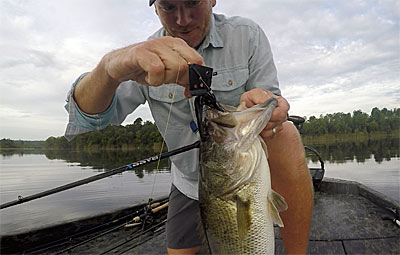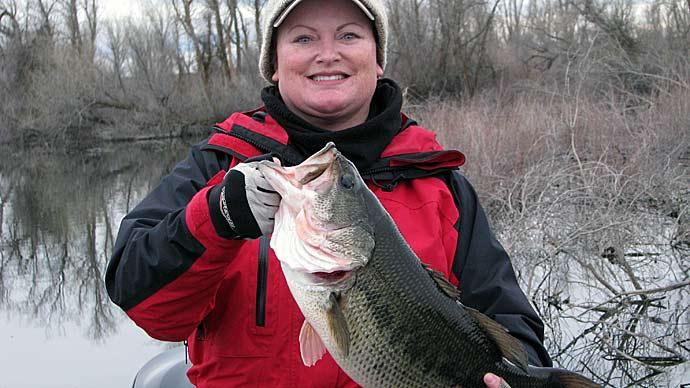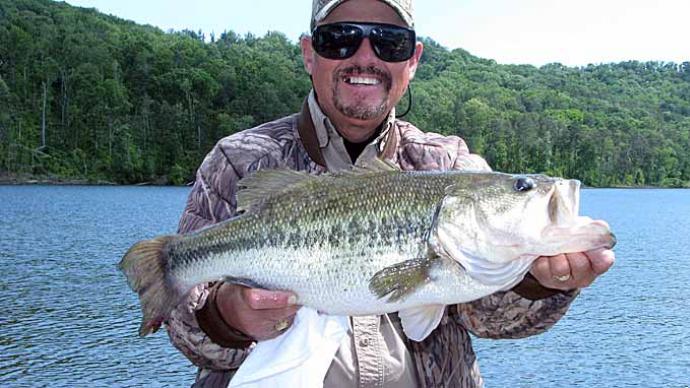
It takes a special kind of angler to target just trophy bass. The angler has to be super-focused, willing to fish all day for a bite or two, and employ some unique tactics for location and tackle. It’s an all-or-nothing approach, but the rewards are many.
“There seems to be a theme if you’re targeting trophy bass. It’s all about location and tackle,” claimed big bass aficionado, Joe Balog. “There are fewer lure options you have to consider when targeting big bass, so a lot of your plan comes down to location and tackle.”
“I get to fish a lot, so if I want to spend an entire day targeting big bass, I can,” he said. “I’m not concerned if I only get one or two or four or no bites. I can always come back tomorrow and catch a bunch of fish. But if you’re after massive bass, you have to prepare yourself for the fact you may only get a bite or two over an entire day, and you have to be mentally and physically prepared to make the most of those opportunities.”
Most guys want to make the most of their free time and catch a bunch of fish when they’re on the water. That cannot be your goal if you’re after the biggest bass.
“You can catch four and five-pound bass by accident, but the odds of catching a massive bass if you’re not targeting them are slim,” said Balog. “Big bass are rare. A 10-pound bass in Florida is rare. That same trophy fish could be 6 pounds in the north or 8 pounds somewhere else, but the biggest bass have seen it all regardless of where you're at. They have seen dozens of different lures over the 6 or 8 or 10 years they’ve been alive, and they often don’t make mistakes. Targeting big bass is mentally taxing. It requires a mental shift from accepting that the number of bites you’re going to get will be drastically reduced. That goes against everything bass anglers are taught. We want lots of bites!”
Location is as important as anything when targeting trophy bass. According to Balog, the place to look is the shallows.
“It’s scarce to catch a big bass when fishing for numbers, like when you’re cranking open water,” offered Balog. “Big bass are consistently shallow near boat docks, flooded timber, and the nastiest, heaviest cover you can find. The biggest bass will feed on occasion on roadbeds and drop-offs, but shallow flats are key because that’s the dinner table. There’s forage diversity in the shallows. Big bass in the shallows can target bluegills and sunfish, crayfish, frogs, ducklings, mice, and many other things that find their way into the water.”
“In any given tournament, the majority of guys will have the “schooling mentality” looking to catch a maximum number of bass, but in those same tournaments, you’ll have guys like a Dean Rojas or Denny Brauer that are going to fish shallow because they know that’s where the biggest bass are. They’re not going to get as many bites there, but they know that. They are looking for quality fish.”
Lure selection for giant bass is somewhat simplified. “The big lure; big fish theory applies when targeting trophy bass,” shared Balog. “The exception is in cold water to a degree. Without a doubt, big bass prefer more natural lures, especially those with their own built-in action.”
Balog said that big-bass lures fall into five categories 1) swimbaits, 2) plastic worms, 3) jigs/trailers, 4) spinnerbaits, and 5) topwater.

"Lures have to have a natural swimming action, movement to really interest big bass,” claimed Balog. “Generally, they have to be quiet without emitting a lot of noise. There are a couple of exceptions. One is a buzzbait, but swimbaits that exhibit a subtle natural swimming motion excel.”
Balog has had success with two swimbaits on giant bass called The Big Hammer and Yamamoto’s Heart Tail. Neither lure are giant baits that we usually assume are needed to attract and fool trophy bass.
The Big Hammer has been around for decades but continues to produce enormous bass for serious anglers. Pro angler Rob Belloni claims, “The thing you will see with the Big Hammer, not with other boot tails, is the distinct body wobble, even on a slow retrieve. The square tail of the Big Hammer causes the entire body to roll side to side, and this dual-action, in my opinion, creates an illusion of life that you don't get when only the tail of the lure is moving.”
The Big Hammer is available in versions up to 6 inches and has been made in the past in 7- and 8-inch versions.
When considering big-bass lures, the Yamamoto’s Heart Tail is on the small side, too, measuring 4.5 inches. Its unique, heart-shaped paddle tail produces a considerable side-to-side vibration that displaces a ton of water that looks natural to trophy, educated bass.
Plastic worms can be big bass medicine. “I’ve caught some huge bass on 8- to 12-inch rubber worms,” said Balog. “They meet the criteria of subtle, natural movement, technique, and look natural. Natural colors like black, blue, and pumpkin work best. Avoid fire tails.”
Jigs and trailers need to be included in the trophy bass arsenal. “I use mainly custom jigs. Smaller, finesse jigs are in vogue right now, but I generally use 3/8 or ½ ounce jigs up to one ounce with a big trailer to imitate crayfish. The overall bait should be as big as your hand,” said Balog. “They tend to work better in colder water.”
Spinnerbaits fool big bass at times. “I’m a big fan of Terminator spinnerbaits,” said Balog. “They run true right out of the box. I use big 5 or 6 Willow-leaf tandem blades that slide through grass and heavy cover. Spinnerbaits work for giant bass because they can be fished in nasty places, cast well on heavy tackle, and have a single, strong hook with which you can stick a big bass.”

Because big bass can generally be found in shallow water, topwater baits can trigger aggressive reactions from rotund leviathans. “Buzzbaits, twitching stickbaits, and frogs are big-bass triggers,” said Balog. “A black Terminator buzzbait is always a go-to lure for big bass. A top-water frog produces because it has a good hook, can be fished in the heaviest cover, and it’s a high percentage bait.”
You wouldn’t think of going elk hunting with a .22. Why would you go in search of trophy bass with average tackle? “You can’t use the same tackle for everyday bass fishing when targeting trophy bass,” declared Balog. “Everything is exaggerated. You’re using heavy lines, heavy lures. You won’t hook big bass with average tackle. They are just harder to hook well. I use a moderate/heavy action 7-foot, 4-inch St. Croix Bass X and 50-pound Suffix 832 braid. I’ve been fishing a new 9-foot extra-heavy St. Croix flippin’ stick that has been working well. Length is the key. A long rod gives you leverage to muscle big fish out of cover, the power for sure hook sets, and most anglers are just not prepared with that kind of tackle.”
Trophy bass are a whole new breed of animal. “You have to rethink everything you do when targeting just trophy bass,” advised Balog. “You don’t run up to a spot and then shut down, put your anchors down before you’re in the perfect spot, drop a rod on the bottom of the boat, or make a bad cast. You can do that and catch smaller bass. Do that when you’re targeting the biggest bass, and the game is over.”




